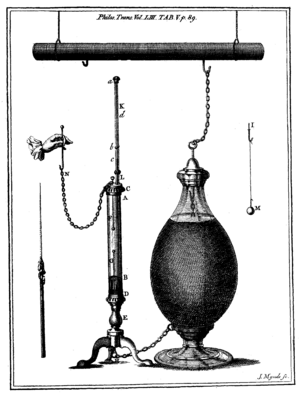Ebenezer Kinnersley facts for kids
Quick facts for kids
Ebenezer Kinnersley
|
|
|---|---|
| Born | 30 November 1711 |
| Died | 4 July 1778 (aged 66) Philadelphia, Pennsylvania, U.S.
|
| Nationality | English |
| Citizenship | United States |
| Known for | Electricity |
| Scientific career | |
| Fields | Physics |
Ebenezer Kinnersley (born November 30, 1711 – died July 4, 1778) was an English scientist, inventor, and lecturer. He was especially known for his amazing work and discoveries about electricity. He worked closely with Benjamin Franklin and helped explain many mysteries of electric power.
Contents
Discovering Electricity
Ebenezer Kinnersley was born in England. When he was young, he moved to America with his family. He lived in Philadelphia, where he showed he was very smart. He became friends with Benjamin Franklin, who was also a famous scientist.
Working with Franklin
Franklin and Kinnersley became very interested in electricity. They heard about experiments using glass tubes and silk. These experiments created electric effects. Soon, many people in Philadelphia were trying these experiments.
Kinnersley spent all his time studying electricity. In just a few years, he and Franklin made many new discoveries. They shared their findings with scientists in Europe. This made "The Philadelphia experiments" famous. Franklin and Kinnersley became well-known for their work.
Amazing Electric Discoveries
Scientists in Europe were also studying "electric fire," as they called it. But the Philadelphia scientists seemed to discover even more. In 1748, Kinnersley showed that electricity could travel through water. He used a long trough filled with water to prove it.
He also invented fun electrical devices. One was a "magical picture" that would shock you if you touched it. He also made bells ring using electricity.
Sharing Knowledge: Lectures
In 1751, Kinnersley started giving lectures. These talks were about "The Newly Discovered Electrical Fire." They were the first of their kind in America or Europe!
First Public Lectures
He put an advertisement in a newspaper. It said he would show experiments. These included famous ones from Europe and new ones from Philadelphia. He would also explain how electricity worked.
His lectures were very popular. People from all walks of life came to watch.
Touring with Science
In September 1751, Kinnersley traveled to Boston. He gave his lectures there. The governor of Boston said the talks were "pleasing to all sorts of people."
While in Boston, Kinnersley made another important discovery. He found differences in electricity made by glass and by sulphur globes. He quickly told Franklin about this. Before this, people thought there were two types of electricity. Kinnersley's work helped prove the idea of positive and negative electricity.
He then visited Newport, Rhode Island, and New York. In March 1752, he suggested how to protect houses from lightning. This was three months before Franklin famously used a kite to draw electricity from clouds.
Later Life and Inventions
In 1753, Kinnersley became a teacher at the College of Philadelphia. He later became a professor of English and public speaking. He held this job until 1772, when he retired due to poor health.
Kinnersley kept working on his experiments. He invented an electrical thermometer. He also proved that electricity could create heat. This was a new idea at the time.
In 1764, he published a book about his lectures. It described many of his experiments in detail. One experiment involved a model of the solar system moved by electricity. He even wondered if the real solar system worked in a similar way.
Kinnersley was very well-known in the United States. His name was often mentioned in Europe too. He was elected to the American Philosophical Society in 1768. He also received a special degree from the College of Philadelphia.
Legacy
There is a window at the University of Pennsylvania that honors Ebenezer Kinnersley.


